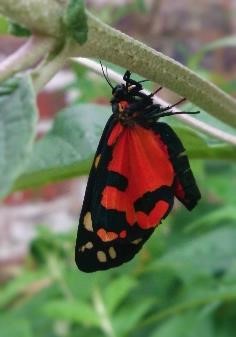Painted Lady or Red Admiral Butterfly Gardens?
Butterflies are beautiful and common throughout the United Kingdom, but even within the same species they do vary. Our initial thinking was that the butterfly we spotted in a garden was a Painted Lady or a Red Admiral? The colouring of the underwing is very similar to a Red Admiral but when opened, the butterfly looked like a Painted Lady. One of our followers has since kindly identified this for us as the Scarlet Tiger Moth (Callimorpha dominula).
 The Scarlet Tiger Moth is generally seen in more southern parts of England and Wales. It is one of the few types of moth which has developed mouthparts, which allows it to feed on nectar. It's presence in the garden is likely explained by the presence of Buddleia trees in the garden, which provide a rich source of nectar. The larvae of the Scarlet Tiger Moth feed on herbaceous plants and, in particular comfrey, which is again found in quantity in the same garden. Scarlet Tiger Moths are most commonly seen in May and June.
The Scarlet Tiger Moth is generally seen in more southern parts of England and Wales. It is one of the few types of moth which has developed mouthparts, which allows it to feed on nectar. It's presence in the garden is likely explained by the presence of Buddleia trees in the garden, which provide a rich source of nectar. The larvae of the Scarlet Tiger Moth feed on herbaceous plants and, in particular comfrey, which is again found in quantity in the same garden. Scarlet Tiger Moths are most commonly seen in May and June.
As for the other butterflies we mentioned, the Painted Lady originates in North Africa. It migrates to the UK and can be found throughout the British Isles in the summer months. Sadly, it dies in the winter months. Their primary food source is thistles, so this means that the Painted Lady can thrive in agricultural land, by the sea, in towns and on mountains. When they first emerge, adults are a beautiful salmon pink colour, but their colour fades as they age. They often tend to have torn wings – probably due to eating those thistles.
The Red Admiral is probably the most well-known butterfly in the UK. It tends to migrate for Europe, but does appear in Britain early in the summer months, so some might be residents. They also die in the winter months, particularly in the colder areas of the UK. Red Admirals love Buddleia, Bramble and Ivy Blossom and are also partial to a bit of rotting fruit!
Do you want to attract butterflies to your garden? Well obviously rotting fruit is not necessarily something you want to start putting your garden, but brambles, ivy blossom and Buddleia are a good starting point.
But other plants that attract butterflies include fennel, evening primrose, red valerian, cowslip and ragged robin. English Lavender is another great plan to attract insects.
But why do you want to attract insects in the first place? Butterflies look pretty, but do they benefit the environment, when their caterpillars might eat the plants?
Yes, caterpillars do eat the plants, but the damage is often minimal, but by providing an environment that is good for butterflies, we have the added benefit of seeing the beautiful creatures flying around our gardens.
And that’s not all, caterpillars also attract birds, so we get to see more species of birds. Birds may also drop seeds into our garden from their beaks or through their droppings, increasing the plant life in our gardens.
Adult butterflies are also attracted to fragrant flowers with bright colouring. They feed on the nectar the flowers product, then travel from one flower to another, pollinating the plants, which further develops the plant species. Many plants rely on butterflies for reproduction.
Other flying insects are also important pollinators, such as bees and hoverflies. They visit flowers and also pollinate other plants. Some plants do pollinate using the wind, but the majority rely on insects.
But wild bees and other pollinators are in decline, so attracting butterflies and other insects to your garden is not just about being able to look at pretty insects, it is also about protecting our plant and flowers’ ability to reproduce.
If you love your garden and the wildlife living there and would like to learn more about gardening, why not have a look at our gardening and horticulture courses?
LEARN WITH ACS
Are you interested in horticulture, wildlife, and the environment? We offer courses in these disciplines and many more.
All of our courses are studied by distance learning - you can start at any time and study at your own pace. You can study from your home or wherever you choose.
During your studies, our expert tutors are onhand to help you with any questions you may have. At the end of each lesson in our courses, there is an assignment for students to complete - this is submitted to the School and returned to you with comments on your work from your tutor.
If you would like
to know more about any of our courses, please do get in touch with us - connect with our expert tutors today.
[08/01/2026 02:51:58]
More from ACS
Short courses, certificates and diplomas -lots of home study options.
Over 150 short courses, certificates and diplomas covering landscaping, crops, plants of all types and general gardening.